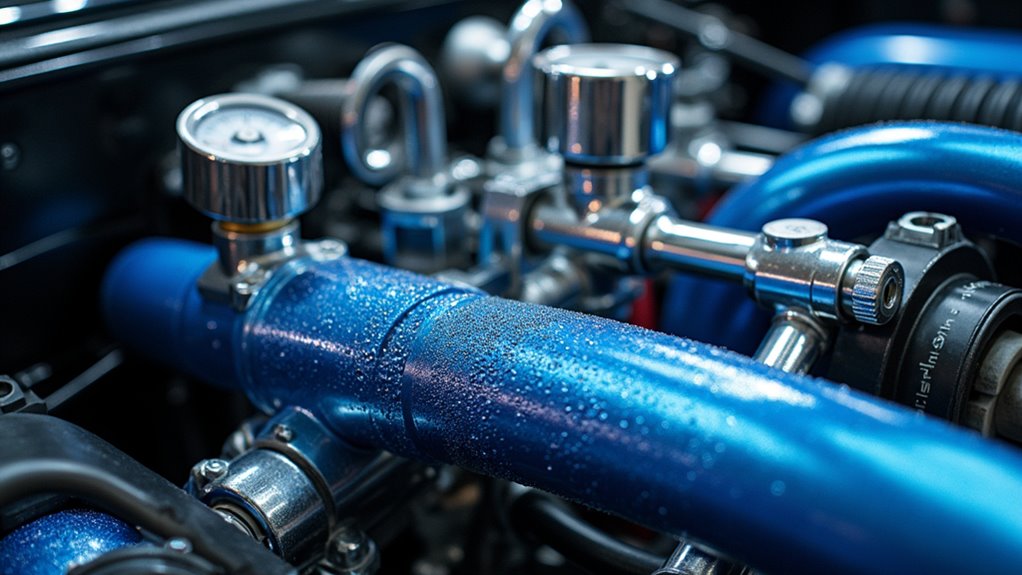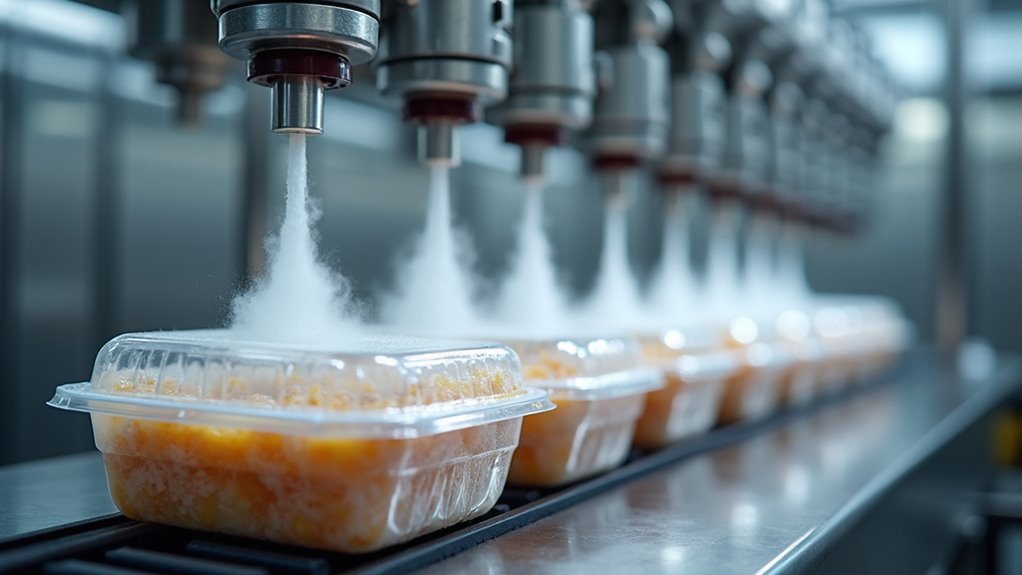Nitrous oxide’s role has expanded far beyond its traditional automotive roots. You’ll find N₂O driving semiconductor manufacturing, where it enables 3D NAND memory production and precision etching processes. It’s revolutionizing food preservation through cryogenic storage and aerospace propulsion systems with thrust ranges from 1N to 25,000N. The market’s projected growth to $3.42B by 2034 reflects its critical importance across multiple sectors, with emerging applications continually reshaping industrial capabilities.
The Evolution of Nitrous Oxide in Automotive Performance

As automotive enthusiasts sought greater performance gains in the 1960s, nitrous oxide emerged as a revolutionary power-adding solution that transformed racing and street performance. You’ll find that N₂O systems evolved from basic drag racing experiments to sophisticated power-adders, delivering 20-50% gains through oxygen-rich combustion enhancement.
Performance tuning considerations have advanced extensively since the early days, with modern systems offering wet and dry delivery options, direct port injection, and hybrid boosting capabilities. While regulatory compliance challenges affect street-legal applications, particularly regarding EPA restrictions and OBD-II modifications, you can still implement N₂O in competition settings.
Today’s systems feature improved safety measures, including sophisticated solenoids, purge systems, and all-encompassing dyno tuning protocols that protect against engine stress and catastrophic failures.
Semiconductor Industry’s Reliance on N2O Technologies
While automotive applications showcase nitrous oxide’s power-boosting capabilities, the semiconductor industry relies on N₂O for far more precise and sophisticated processes. You’ll find this compound instrumental in achieving reliability augmentation and defect minimization across critical manufacturing steps.
N₂O-based Chemical Vapor Deposition creates ultra-thin oxide layers for transistors, enabling precise thickness control down to sub-7nm nodes. Advanced memory technologies like 3D NAND and MRAM depend on N₂O-processed oxides for stable charge storage and magnetic tunnel junctions. Plasma-enhanced processes utilize N₂O for selective etching and surface treatments, pivotal for high-aspect-ratio feature formation. Through-silicon vias and 3D packaging solutions harness N₂O-based oxide liners to prevent copper migration and maintain signal integrity in stacked architectures.
These applications demonstrate N₂O’s essential role in modern semiconductor fabrication processes.
Modern Food Packaging and Preservation Methods

Moving from semiconductor precision to food preservation, nitrous oxide’s versatility extends into modern packaging technologies. You’ll find N2O’s applications vital in cryogenic storage techniques, where it maintains product integrity by minimizing oxygen exposure through inert atmosphere creation. The process operates at 1-6 atmospheres absolute, utilizing vacuum systems to displace oxygen before reintroducing N2O. Preserving food samples requires adding sodium hydroxide solution to prevent biological activity and maintain product stability. This approach effectively extends shelf life while maintaining original flavors and product quality. Using a nitrogen generator on-site provides a more cost-effective solution for continuous food preservation operations.
The system requires maintaining pressures just slightly above atmospheric levels, using food-grade N2O with >99% purity. When you’re implementing these systems, you’ll need to guarantee leak-proof seals and non-reactive materials, particularly in environments exceeding 10 bar. This technology seamlessly combines with other preservation methods, improving overall product shelf life.
You can apply this preservation method across diverse food products, from dairy to coffee, while integrating it with existing industrial processes.
Aerospace Applications and Propulsion Innovations
Through recent innovations in aerospace propulsion, nitrous oxide has emerged as a cornerstone technology for next-generation spacecraft systems. This non-toxic propellant revolutionizes in-space propulsion demonstrations while addressing critical orbital debris mitigation requirements. The use of domestically produced materials ensures a resilient and reliable supply chain for space missions. The widespread adoption by over fifty thrusters currently operating in orbit demonstrates proven flight heritage. Dawn Aerospace has achieved successful launches on nearly all recent SpaceX Transporter missions.
You’ll find scalable thrust ranges from 1N to 25,000N, enabling applications from CubeSats to large spacecraft with proven reliability across 100+ operational thrusters. You can achieve rapid deployment within 24-hour launch windows due to simplified fueling processes and self-pressurizing properties. You’re able to conduct missions from LEO to deep space, including GEO servicing and lunar trajectories. You’ll benefit from reduced operational costs and amplified safety protocols compared to traditional hypergolic fuels.
This green propulsion technology‘s versatility and performance continue driving its adoption across commercial and government space programs.
Market Growth and Economic Impact Analysis
Beyond aerospace applications, the nitrous oxide market demonstrates sturdy financial performance across multiple sectors. You’ll find the market’s projected growth from USD 1.72 billion in 2025 to USD 3.42 billion by 2034 is driven by diverse industrial applications and healthcare infrastructure expansion. Environmental concerns are pushing industries to develop eco-friendly alternatives, as human activities contribute to 40% of global N2O emissions. The industry is expected to reach a remarkable value of USD 4.1 billion by 2037, showcasing its robust growth trajectory.
The Asia-Pacific region leads market development, controlling 37% of global share, with emerging market opportunities particularly strong in China and India. You’re seeing this growth primarily fueled by aging populations and increasing chronic disease management needs. The medical sector particularly values the 99.999% purity grade for its superior safety profile in surgical procedures. The region’s 8.05% CAGR outpaces global averages, supported by expanding medical facilities and automotive sector demand.
While medical applications remain dominant, you’ll notice significant market penetration in food processing, semiconductor manufacturing, and motorsports, creating a durable, multi-sector economic impact.
Safety Protocols in Industrial N2O Usage
Safety considerations for industrial N₂O usage demand an extensive, multi-layered approach to risk management. When implementing cryogenic storage safety protocols, you’ll need to focus on both systemic and operational controls while meeting personnel training requirements.
Key safety measures you must implement:
- Control ignition sources by preventing welding near N₂O systems and using oxygen-compatible cleaners on surfaces
- Monitor exposure levels through gas detection equipment and maintain ventilation systems that keep concentrations below 2 ppm
- Select appropriate materials and lubricants that resist N₂O decomposition while avoiding electric immersion heaters
- Establish leak detection protocols with immediate evacuation procedures and regular inspection schedules
Proper storage requires keeping nitrous oxide cylinders in cool, dry areas away from direct sunlight to prevent degradation and potential hazards.
Maintain thorough documentation of all safety measures, including training records and system maintenance logs, to guarantee regulatory compliance and operational excellence.
Environmental Benefits of Nitrous Oxide Systems
While nitrous oxide itself poses environmental challenges as a potent greenhouse gas, implementing optimized N₂O systems in industrial processes yields significant ecological benefits when properly managed. Modern wastewater treatment facilities have found that activated sludge processes can be optimized to minimize emissions. Agricultural practices contribute significantly as soil microorganisms drive nitrogen cycling in farmlands. You’ll find that green infrastructure integration enables facilities to reduce emissions by up to 300 times compared to traditional CO₂ outputs, while generating carbon offset credit mechanisms for compliant industries. Cross-sectoral strategies demonstrate that practical abatement measures could reduce N₂O emissions by over 40% from current levels.
| Benefit Category | Direct Impact | Economic Value | Implementation |
|---|---|---|---|
| Climate Action | Reduces GHG emissions | Carbon credits | Abatement tech |
| Water Quality | Prevents runoff | Cost savings | Filtration systems |
| Air Protection | Minimizes ozone formation | Health benefits | Emission controls |
| Resource Efficiency | Optimizes nitrogen use | Productivity gains | Circular processes |
These systems support the 1.5°C climate target while protecting water resources and improving air quality through sustainable nitrogen management strategies.
Manufacturing Process Optimization With N2O
As semiconductor manufacturing advances in the direction of sub-5nm nodes, N₂O-based process optimization has become essential for achieving precision control and high-quality outputs. You’ll find integrated N₂O systems revolutionizing chemical vapor deposition recipes and advanced doping techniques across modern fabrication facilities. The gas’s slightly sweet odor serves as a natural indicator for leak detection during system maintenance and safety checks. Recent studies show that carbon felt electrodes enhance N₂O conversion performance compared to traditional graphite materials in industrial applications.
Key process optimizations you can implement with N₂O include:
- Automated gas distribution systems that maintain stable supply for continuous production while meeting SEMI F5-0221 standards
- Model-based control programs that optimize concentration, temperature, and pressure parameters in real-time
- Precision-controlled thermal decomposition processes that amplify reaction efficiency and safety
- Contamination-free deposition environments that enable uniform film properties across large wafer batches
These developments support high-volume manufacturing while ensuring consistent quality and reducing defect rates in advanced semiconductor nodes.
Global Supply Chain and Distribution Networks
Since global nitrous oxide distribution requires sophisticated logistics networks, you’ll find specialized industrial gas distributors operating through interconnected regional hubs and digital platforms. These suppliers maintain regional nitrous oxide storage facilities, with companies like Airgas operating over 1,400 locations across the US for medical-grade supply.
You’ll encounter cost-effective distribution models customized to specific markets, with Asian networks prioritizing semiconductor manufacturing and US systems focusing on medical applications. Digital tracking platforms guarantee supply chain transparency while meeting strict safety protocols.
The infrastructure supports a growing market projected to reach $2.2B by 2030, with suppliers investing in high-capacity cryogenic tanks and automated delivery systems to meet increasing semiconductor and food industry demands.
Research and Development Breakthroughs
Recent breakthroughs in nitrous oxide research span multiple sectors, with significant advancements in medical applications, sustainable agriculture, and food processing technologies.
You’ll find the pharmaceutical pipeline expansion particularly evident in these key developments:
- Medical research output has more than doubled since 1980, with 5,801 articles enhancing clinical translation feasibility
- Pioneering mechanical gas conversion methods now achieve 50% conversion to potassium nitrate fertilizer within 50 hours
- Biodegradable packaging innovations incorporate N₂O-mediated triggers for preservative release
- Cutting-edge food preservation techniques utilize N₂O’s ethylene-inhibiting properties to extend produce shelf life
These breakthroughs demonstrate remarkable progress in addressing climate concerns while maximizing N₂O’s utility across industries. The research continues to unveil new applications, from sustainable fertilizer production to groundbreaking medical treatments.
Frequently Asked Questions
How Does Nitrous Oxide Affect Material Hardness During Semiconductor Fabrication Processes?
When you utilize nitrous oxide in semiconductor processing, you’ll achieve amplified material hardness control through improved oxidation and nitridation mechanisms.
The process strengthens Si-O and Si-N bonds at interfaces, directly augmenting radiation hardness in gate oxides. You can optimize semiconductor process optimization by controlling thermal annealing conditions, which reduces defect density and improves crystalline structure. This results in more solid devices with superior stress resistance and long-term reliability.
What Alternative Gases Can Replace Nitrous Oxide in Food Preservation Systems?
Based on the research requirements, here are organized findings about alternative gases for food preservation:
CARBON DIOXIDE APPLICATIONS
- Achieves 99% microbial reduction in modified atmosphere packaging
- Maintains 45-60% longer shelf life in meat products
- Creates carbonic acid barrier at 20-30% concentration
- Provides appropriate preservation at 2-5°C storage temperatures
- Extends fresh produce shelf life by 40% through controlled atmospheres
NITROGEN GAS APPLICATIONS
- Displaces oxygen with 99.99% purity rating
- Reduces oxidation by creating inert environment
- Prevents package collapse through structural support
- Maintains crispy texture in snack foods
- Creates protective barrier in sealed containers
OXYGEN-CONTROLLED SYSTEMS
- Regulates oxidation rates in packaged foods
- Maintains 2-3% oxygen levels for fresh produce
- Controls enzymatic browning reactions
- Supports beneficial aerobic processes
- Enables selective microbial control
MIXED GAS COMBINATIONS
- Blends CO2/N2 at 30/70 ratio for meat preservation
- Utilizes tri-gas mixtures for specialty applications
- Achieves appropriate gas balance for different food types
- Creates customized preservation environments
- Provides flexibility in preservation systems
How Long Can Nitrous Oxide Be Stored Before Degrading?
You’ll find that nitrous oxide’s shelf life considerations depend primarily on proper storage conditions. When you maintain temperatures between 32°F and 122°F, your N₂O can remain stable for up to 5 years in properly maintained cylinders.
Storage temperature impacts greatly affect longevity – if you keep tanks at ideal room temperature (68-72°F), you’ll optimize stability. You should always check manufacturer expiration dates and monitor pressure levels regularly for degradation signs.
Can Nitrous Oxide Improve Electric Vehicle Battery Manufacturing Efficiency?
While you’ll find limited direct applications for nitrous oxide in EV battery manufacturing, it’s not a significant factor in improving battery efficiency. The primary focus remains on optimizing battery chemistry and manufacturing processes through established methods.
Your efforts would be better directed at proven techniques for boosted battery charging rates and improved energy density through advanced cathode materials and refined cell assembly processes.
What Temperature Ranges Are Optimal for Nitrous Oxide Performance in Industrial Applications?
You’ll find best N2O performance between -5.5°C and 250°C in industrial settings.
At cryogenic temperature conditions below -88°C, you risk material embrittlement and phase separation issues.
In high pressure environments (116.5-207 bar), you must maintain temperatures above -17°C to prevent condensation.
For industrial synthesis, you’ll want to operate around 250°C with phosphate additives, while staying below 300°C to avoid flammability risks.

